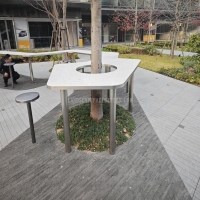Welcome to the website for landscape facilities products and knowledge.
How does the table perform in high-wind environments to prevent tipping or movement?
Outdoor tables face significant challenges in windy environments where tipping or shifting can cause damage and safety hazards. Manufacturers employ multiple engineering strategies to ensure stability, beginning with weighted base systems that lower the center of gravity. Unlike indoor furniture, quality outdoor tables incorporate substantial materials in their foundation—often concrete-filled steel bases or integrated weight systems that provide ballast against uplift forces.
Aerodynamic design principles play a crucial role in wind resistance. Tables with perforated surfaces or slatted designs allow wind to pass through rather than creating a solid barrier that catches gusts. This strategic ventilation reduces lateral pressure that could otherwise topple the structure. Additionally, rounded edges and tapered profiles minimize wind resistance compared to flat, broad surfaces.
Anchoring systems provide another layer of security. Many outdoor tables feature ground anchor compatibility, allowing permanent installation in particularly exposed locations. These hidden anchoring points enable secure attachment to decks, patios, or permanent bases without compromising aesthetics. For temporary setups, integrated sand or water reservoirs within the base offer adjustable ballast that users can modify based on weather conditions.
Material selection significantly impacts performance in windy settings. Heavy natural stones like granite or engineered composite materials provide inherent mass, while strategically placed support crossbars prevent lateral movement. The relationship between table height and base width also follows engineering principles—wider bases relative to height create more stable platforms that resist tipping moments.
Advanced manufacturing techniques now allow for wind-tunnel testing during development, ensuring tables can withstand specific wind speeds before reaching consumers. This testing validates design elements from leg configuration to surface patterns, creating furniture that maintains position even during sudden gust events common in coastal or elevated locations.
Through these combined approaches—strategic weighting, aerodynamic shaping, anchoring options, and material science—modern outdoor tables achieve remarkable stability. Properly engineered designs can resist winds exceeding 50 mph without additional securing, providing peace of mind for homeowners in wind-prone regions while maintaining the aesthetic appeal expected of quality outdoor furnishings.
Related search:

Recommendation
An outdoor bar counter with stainless steel and terrazzo materials in an irregular shape